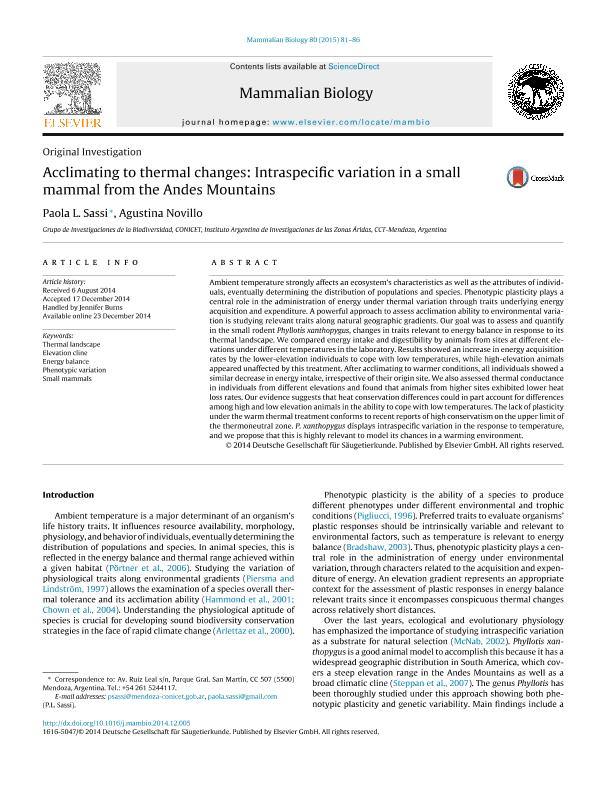Mostrar el registro sencillo del ítem
dc.contributor.author
Sassi, Paola Lorena

dc.contributor.author
Novillo, Agustina

dc.date.available
2018-05-22T21:04:00Z
dc.date.issued
2015-03
dc.identifier.citation
Sassi, Paola Lorena; Novillo, Agustina; Acclimating to thermal changes: Intraspecific variation in a small mammal from the Andes Mountains; Elsevier Gmbh; Mammalian Biology; 80; 2; 3-2015; 81-86
dc.identifier.issn
1616-5047
dc.identifier.uri
http://hdl.handle.net/11336/45959
dc.description.abstract
Ambient temperature strongly affects an ecosystem's characteristics as well as the attributes of individuals, eventually determining the distribution of populations and species. Phenotypic plasticity plays a central role in the administration of energy under thermal variation through traits underlying energy acquisition and expenditure. A powerful approach to assess acclimation ability to environmental variation is studying relevant traits along natural geographic gradients. Our goal was to assess and quantify in the small rodent Phyllotis xanthopygus, changes in traits relevant to energy balance in response to its thermal landscape. We compared energy intake and digestibility by animals from sites at different elevations under different temperatures in the laboratory. Results showed an increase in energy acquisition rates by the lower-elevation individuals to cope with low temperatures, while high-elevation animals appeared unaffected by this treatment. After acclimating to warmer conditions, all individuals showed a similar decrease in energy intake, irrespective of their origin site. We also assessed thermal conductance in individuals from different elevations and found that animals from higher sites exhibited lower heat loss rates. Our evidence suggests that heat conservation differences could in part account for differences among high and low elevation animals in the ability to cope with low temperatures. The lack of plasticity under the warm thermal treatment conforms to recent reports of high conservatism on the upper limit of the thermoneutral zone. P. xanthopygus displays intraspecific variation in the response to temperature, and we propose that this is highly relevant to model its chances in a warming environment.
dc.format
application/pdf
dc.language.iso
eng
dc.publisher
Elsevier Gmbh

dc.rights
info:eu-repo/semantics/openAccess
dc.rights.uri
https://creativecommons.org/licenses/by-nc-sa/2.5/ar/
dc.subject
Thermal Landscape
dc.subject
Elevation Cline
dc.subject
Energy Balance
dc.subject
Phenotipic Variation
dc.subject
Small Mammals
dc.subject.classification
Otras Ciencias Biológicas

dc.subject.classification
Ciencias Biológicas

dc.subject.classification
CIENCIAS NATURALES Y EXACTAS

dc.title
Acclimating to thermal changes: Intraspecific variation in a small mammal from the Andes Mountains
dc.type
info:eu-repo/semantics/article
dc.type
info:ar-repo/semantics/artículo
dc.type
info:eu-repo/semantics/publishedVersion
dc.date.updated
2018-04-24T14:55:15Z
dc.journal.volume
80
dc.journal.number
2
dc.journal.pagination
81-86
dc.journal.pais
Alemania

dc.journal.ciudad
Berlín
dc.description.fil
Fil: Sassi, Paola Lorena. Consejo Nacional de Investigaciones Científicas y Técnicas. Centro Científico Tecnológico Conicet - Mendoza. Instituto Argentino de Investigaciones de las Zonas Áridas. Provincia de Mendoza. Instituto Argentino de Investigaciones de las Zonas Áridas. Universidad Nacional de Cuyo. Instituto Argentino de Investigaciones de las Zonas Áridas; Argentina
dc.description.fil
Fil: Novillo, Agustina. Consejo Nacional de Investigaciones Científicas y Técnicas. Centro Científico Tecnológico Conicet - Mendoza. Instituto Argentino de Investigaciones de las Zonas Áridas. Provincia de Mendoza. Instituto Argentino de Investigaciones de las Zonas Áridas. Universidad Nacional de Cuyo. Instituto Argentino de Investigaciones de las Zonas Áridas; Argentina
dc.journal.title
Mammalian Biology

dc.relation.alternativeid
info:eu-repo/semantics/altIdentifier/url/https://www.sciencedirect.com/science/article/pii/S1616504714001566
dc.relation.alternativeid
info:eu-repo/semantics/altIdentifier/doi/http://dx.doi.org/10.1016/j.mambio.2014.12.005
Archivos asociados
